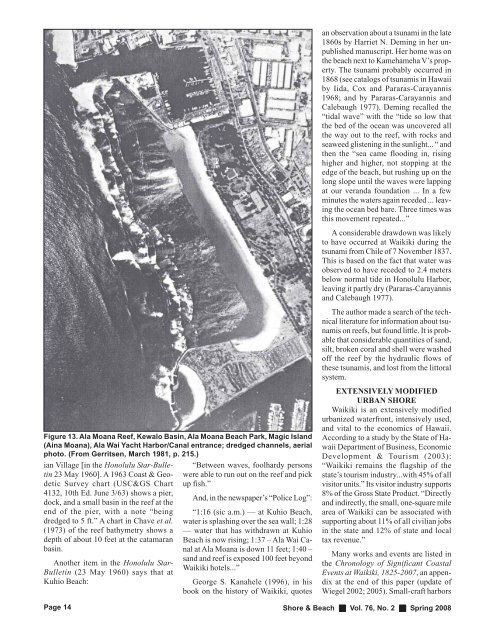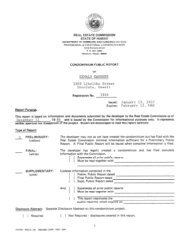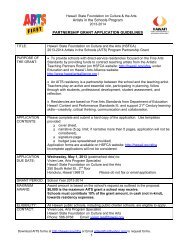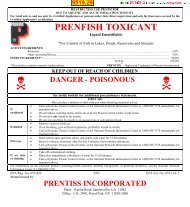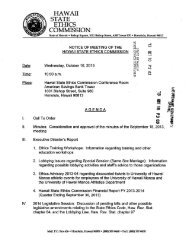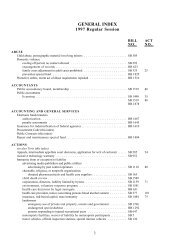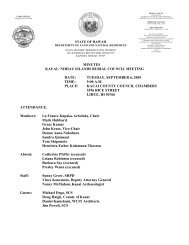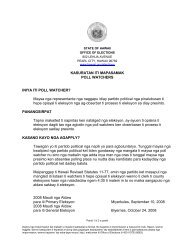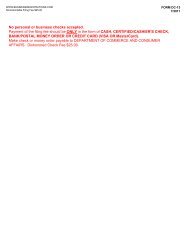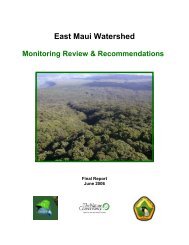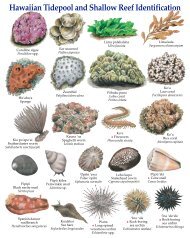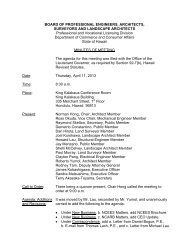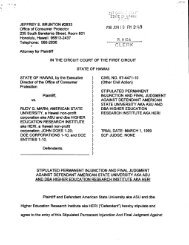Waikiki Beach: History of its transformation - Hawaii.gov
Waikiki Beach: History of its transformation - Hawaii.gov
Waikiki Beach: History of its transformation - Hawaii.gov
Create successful ePaper yourself
Turn your PDF publications into a flip-book with our unique Google optimized e-Paper software.
Figure 13. Ala Moana Reef, Kewalo Basin, Ala Moana <strong>Beach</strong> Park, Magic Island<br />
(Aina Moana), Ala Wai Yacht Harbor/Canal entrance; dredged channels, aerial<br />
photo. (From Gerr<strong>its</strong>en, March 1981, p. 215.)<br />
ian Village [in the Honolulu Star-Bulletin<br />
23 May 1960]. A 1963 Coast & Geodetic<br />
Survey chart (USC&GS Chart<br />
4132, 10th Ed. June 3/63) shows a pier,<br />
dock, and a small basin in the reef at the<br />
end <strong>of</strong> the pier, with a note “being<br />
dredged to 5 ft.” A chart in Chave et al.<br />
(1973) <strong>of</strong> the reef bathymetry shows a<br />
depth <strong>of</strong> about 10 feet at the catamaran<br />
basin.<br />
Another item in the Honolulu Star-<br />
Bulletin (23 May 1960) says that at<br />
Kuhio <strong>Beach</strong>:<br />
Page 14<br />
“Between waves, foolhardy persons<br />
were able to run out on the reef and pick<br />
up fish.”<br />
And, in the newspaper’s “Police Log”:<br />
“1:16 (sic a.m.) — at Kuhio <strong>Beach</strong>,<br />
water is splashing over the sea wall; 1:28<br />
— water that has withdrawn at Kuhio<br />
<strong>Beach</strong> is now rising; 1:37 – Ala Wai Canal<br />
at Ala Moana is down 11 feet; 1:40 –<br />
sand and reef is exposed 100 feet beyond<br />
<strong>Waikiki</strong> hotels...”<br />
George S. Kanahele (1996), in his<br />
book on the history <strong>of</strong> <strong>Waikiki</strong>, quotes<br />
an observation about a tsunami in the late<br />
1860s by Harriet N. Deming in her unpublished<br />
manuscript. Her home was on<br />
the beach next to Kamehameha V’s property.<br />
The tsunami probably occurred in<br />
1868 (see catalogs <strong>of</strong> tsunamis in <strong>Hawaii</strong><br />
by Iida, Cox and Pararas-Carayannis<br />
1968; and by Pararas-Carayannis and<br />
Calebaugh 1977). Deming recalled the<br />
“tidal wave” with the “tide so low that<br />
the bed <strong>of</strong> the ocean was uncovered all<br />
the way out to the reef, with rocks and<br />
seaweed glistening in the sunlight... “ and<br />
then the “sea came flooding in, rising<br />
higher and higher, not stopping at the<br />
edge <strong>of</strong> the beach, but rushing up on the<br />
long slope until the waves were lapping<br />
at our veranda foundation ... In a few<br />
minutes the waters again receded ... leaving<br />
the ocean bed bare. Three times was<br />
this movement repeated...”<br />
A considerable drawdown was likely<br />
to have occurred at <strong>Waikiki</strong> during the<br />
tsunami from Chile <strong>of</strong> 7 November 1837.<br />
This is based on the fact that water was<br />
observed to have receded to 2.4 meters<br />
below normal tide in Honolulu Harbor,<br />
leaving it partly dry (Pararas-Carayannis<br />
and Calebaugh 1977).<br />
The author made a search <strong>of</strong> the technical<br />
literature for information about tsunamis<br />
on reefs, but found little. It is probable<br />
that considerable quantities <strong>of</strong> sand,<br />
silt, broken coral and shell were washed<br />
<strong>of</strong>f the reef by the hydraulic flows <strong>of</strong><br />
these tsunamis, and lost from the littoral<br />
system.<br />
EXTENSIVELY MODIFIED<br />
URBAN SHORE<br />
<strong>Waikiki</strong> is an extensively modified<br />
urbanized waterfront, intensively used,<br />
and vital to the economics <strong>of</strong> <strong>Hawaii</strong>.<br />
According to a study by the State <strong>of</strong> <strong>Hawaii</strong><br />
Department <strong>of</strong> Business, Economic<br />
Development & Tourism (2003):<br />
“<strong>Waikiki</strong> remains the flagship <strong>of</strong> the<br />
state’s tourism industry...with 45% <strong>of</strong> all<br />
visitor un<strong>its</strong>.” Its visitor industry supports<br />
8% <strong>of</strong> the Gross State Product. “Directly<br />
and indirectly, the small, one-square mile<br />
area <strong>of</strong> <strong>Waikiki</strong> can be associated with<br />
supporting about 11% <strong>of</strong> all civilian jobs<br />
in the state and 12% <strong>of</strong> state and local<br />
tax revenue.”<br />
Many works and events are listed in<br />
the Chronology <strong>of</strong> Significant Coastal<br />
Events at <strong>Waikiki</strong>, 1825-2007, an appendix<br />
at the end <strong>of</strong> this paper (update <strong>of</strong><br />
Wiegel 2002; 2005). Small-craft harbors<br />
Shore & <strong>Beach</strong> Vol. 76, No. 2 Spring 2008


